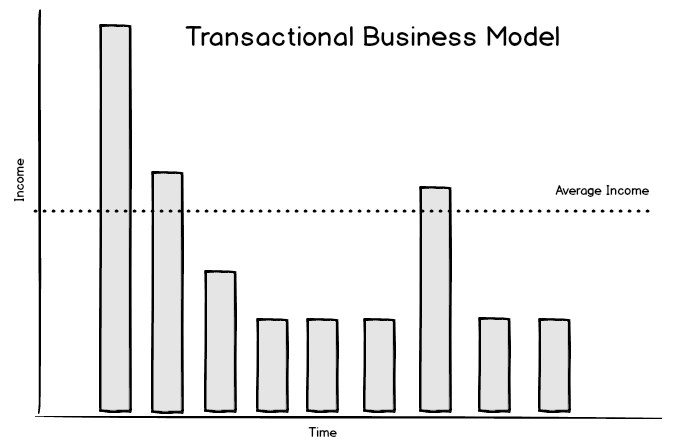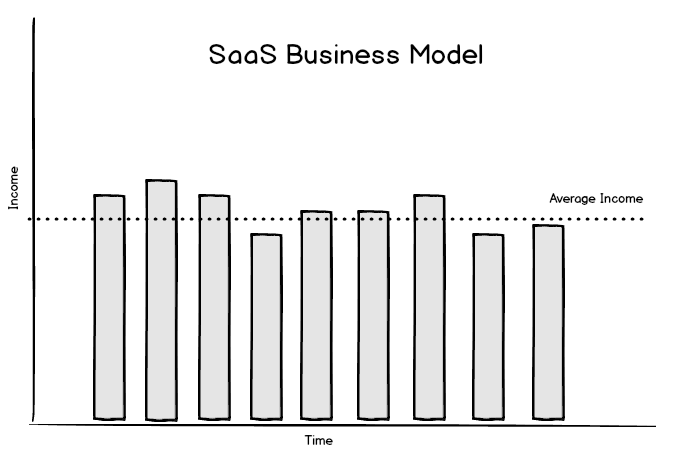The software market has evolved since the early days as has the business models behind them. Software has evolved from initially being custom designed to suit a specific one off piece or hardware to a packaged. The SaaS market has grown from $5.6Bn in 2008 to an estimated value of $157Bn in 2020 according to Statistica. The figures show that growth has been running at an average of 18% a year over the last 5 years. This compares to a global software market size of $624Bn in 2020 which is only growing at 3.7% according to CompTIA/IDC. So, what makes Software as a Service (SaaS) different and why is it growing so much faster then the software market in general?

Transactional Software Business Model
The traditional business model for software has been transactional. The customer pays a substantial amount up front to buy the software licenses and to pay for the implementation and training. The software is normally hosted on the businesses own infrastructure but it can also be install on a virtual server.
In addition, the business pays a smaller amount (typically around 20%) to cover ongoing support. This support normally includes minor bug fixes and changes required to keep the current version of the software running and provide customer service. This does not normally include new features as these are normally included only in new versions of the software. If the business wants to upgrade their software version they have to pay an additional charge to purchase the licenses for the newer version as well as any costs involved in installing the new software and possibly converting existing data to the work with the new version.

Advantages of the Transactional Software Business Model
- Ownership - Normally when a business purchases a software system they own a perpetual license to use the software. This means that there is no requirement to make future payments to continue using the software.
- Control - An in-house software application gives a business a high degree of control. This makes it possible to defer upgrades or changes to the system when they are not required by the business. Depending on the specific requirements this can be for many many years.
- Security & Data Concerns - Some businesses prefer to keep their data under their own control. This can be a requirement due to data protection regulations but this is changing rapidly as more software moves into the cloud, including businesses moving licensed software on to cloud based servers.
- Connectivity Issues - Despite the increasing availability of broadband and mobile data, there are still some locations which do not a great data connection. If this is an issue then you can just run your software system from a on-premise server.
- Performance - Software installed locally on a client device will often perform better than hosted applications. This is particularly the case when for performance heavy applications like video editing or computer aided design.
Software as a Service (SaaS) Business Model
The Software as a Service model is different. Rather than the large up front cost it is a largely a steady cost from period to period. The only variations are pricing changes or upgrades or downgrades on the subscriptions (i.e. additional or reduced user seats). Another possible change is if the customer changes from a "basic" subscription to a "professional" (or "premium") subscriptions which offer additional features which they find useful.
Since this is really a service it is constantly being updated and changed so that the vendor does not need to maintain multiple different versions of the software.

Advantages of SaaS over Transactional Model
- Lower initial cost - Since Software as a Service is subscription based and has no initial license fees resulting on a lower cost to get started
- Quick Setup & Deployment - Since the SaaS application is already installed and configured in the cloud it is immediately available
- Constant Upgrades - Because it is a service rather than a software license then there is no requirement to pay for upgrades as they are included in the ongoing cost.
- Accessibility - Since the application is web based it is generally available on a variety of devices, including PCs, tablets and phones. It is also possible to use the application in the office and while on the move or remote working.
- Scalability - The customer does not need to have server infrastructure so it is easy to scale. The subscription is flexible and can be changed as needed, eg when the business grows or hires more employees.
- Best of Breed - SaaS based solutions tend to solve a specific issue like sending mailshots (ie MailChimp), blogging (Ghost), customer communications (Intercom) etc. These applications can be easily integrated so a business can pick the best solution for their requirements and link them together either directly or by using solutions like IFTTT or Zapier.

The Implications of the Growth of SaaS
SaaS has made a huge range of applications available at a reasonable cost. Since these applications are web based, they are available on any device which has a web browser so it no longer matters which operating system or device is used. This change has persuaded IT vendors like Microsoft and Apple to offer their operating system upgrades for free.
The challenge for SaaS vendors is that unlike the transactional model where the charges generally align to the cost of providing the solution to the customer and any additional work is chargeable, in the case of SaaS, the initial charges often do not cover the additional cost of on-boarding a new customer.
While B2C offering like Netflix or Spotify have a simple interface with a limited number of features (but lots of content!!), it is relatively easy for users to get up and running and it does not require a customer success person to explain how to use the system.
However, B2B customers frequently pay much more for their subscription and expect a much higher level of service. This is particularly important in the initial stages when the customer is getting familiar with the SaaS system and needs help to transfer data from existing systems or possibly to integrate the SaaS solution with current legacy applications. This means that the SaaS vendor often has to keep the customer for a long enough time to re-coupe the initial setup costs. So tracking customer churn reasons is particularly important.
So the economics of SaaS mean a more predictable cash-flow for both the customer and the vendor but creates a funding requirement for the vendor to cover the cost of getting the customer up and running.



